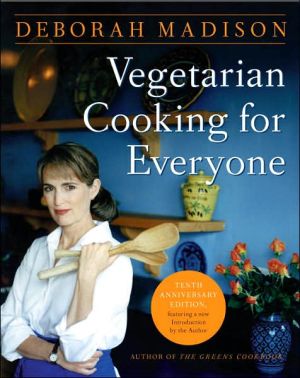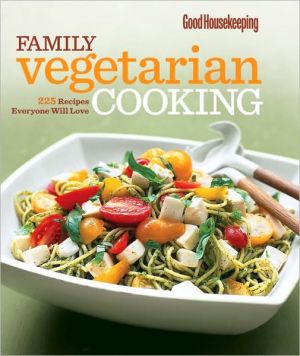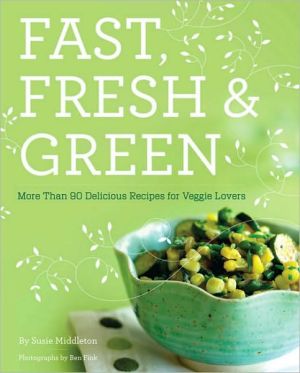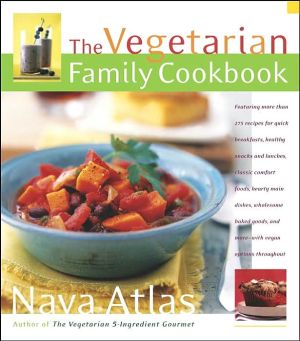Vegetarian Cooking for Everyone
The tenth anniversary edition of this landmark cookbook, with more than 325,000 copies in print, includes a new introduction from Deborah Madison, America’s leading authority on vegetarian cooking.\ What Julia Child is to French cooking, Deborah Madison is to vegetarian cooking—a demystifier and definitive guide to the subject. After her many years as a teacher and writer, she realized that there was no comprehensive primer for vegetarian cooking, no single book that taught vegetarians basic...
Search in google:
This immensely appealing award-winning book of more than 1,400 recipes takes vegetarian cooking to new heights of elegance and flavor. Author Deborah Madison's love of fresh and beautiful produce and high-quality ingredients comes through on every page of Vegetarian Cooking for Everyone; soups both refined and homey, inventive salads, pastas, vegetable dishes, luxurious gratins and casseroles, beans, grains, stews, stir-fries, and more, combine those ingredients in wonderful ways. For anyone who's ever wondered how to structure a meal without meat as the centerpiece, this book provides a decisive and delicious answer. Publishers Weekly Many have tried to create a reliable, encyclopedic vegetarian cookbook, but few have succeeded. Madison (The Greens Cookbook; The Savory Way) comes through with a weighty volume that contains reams of useful information, basic techniques and just plain great recipes. Madison admits that she herself is not a strict vegetarian. She is, however, strict about organization. She uses common sense in assembling a formidable volume of material, sometimes opting for suggestions or outlines rather than full recipes. A section on crudits in the appetizer chapter lists familiar (cucumbers) and less familiar (jicama) vegetables and details how to prepare them; soup recipes are preceded by an outline of how vegetable soups are generally created. Madison respects tradition just the right amount, which means that the chapter on soy foods combines tofu and tempeh with Asian flavors, as in Malaysian-Inspired Tofu Curry and Marinated and Fried Tempeh, Indonesian Style. As a rule, her recipes are full of intriguing flavors, but they're never wacky: Peruvian Potatoes with Peanut Sauce and Garnishes; Chard Stems with Saffron and Tomatoes; Broken Lasagne with Fried Green Tomatoes and Parsley; Millet with Pan-Roasted Corn and Tomatillo Salsa. A chapter on breakfast foods that are good anytime - like Cottage Cheese and Nutmeg Pancakes - is particularly strong, but it would be difficult to select a favorite section from this incredibly complete and triumphant effort. (Oct.)
Warm Crostini with Blue Cheese and Walnuts\ I love to serve these with a glass of sherry, a bowl of pumpkin soup, or a salad of pears and endive. The butter melts into the crisp toast; the cheese stays on top. It's heady and very aromatic.\ Makes 8\ 8 slices baguette or country bread\ 4 ounces Roquefort, Maytag, or Danish blue\ 3 tablespoons butter at room temperature\ 1 teaspoon cognac\ 1/4 cup finely chopped walnuts Freshly milled pepper Finely chopped parsley\ Toast the bread under the broiler until nicely browned on one side, then a little less so on the second. Cream the cheese and butter until smooth, then work in the cognac and three-quarters of the walnuts and season with pepper. Spread on the paler side of the toasts, then broil until the cheese is bubbling. Remove, dust with the remaining nuts, and garnish with parsley. Serve warm.\ Lentil Soup\ Savored over a large part of the world, lentil soups are one of the best-liked, easiest-to-cook, and most varied of soups. The earthy flavor of lentils is complemented by Indian spices, Western herbs, cream, tomato, greens, and anything slightly tart, such as sorrel or lemon.\ German brown lentils are the ones we see most commonly, and they make good soups. But the tiny French slate-green Le Puy lentils, available at specialty stores and in bulk at many natural food stores, make the prettiest and most delicious soups. They're entirely worth the slight extra cost, and in my kitchen they are the lentil of choice. Indian red split lentils turn yellow when cooked and fall into a puree, as do other split lentils, which makes them ideal for smooth lentil soups.\ Lentils don't need to be soaked, but they do need to be picked over for tiny stones. They cook in just 25 minutes, and salt should be added at the beginning. Like most bean soups, lentil soups taste better a day after they're made.\ Lentil Minestrone\ This is one of my all-time favorite soups. It's better when cooked ahead of time, but add the cooked pasta and greens just before serving so that they retain their color and texture.\ Serves 4 to 6\ 2 tablespoons olive oil, plus extra virgin to finish\ 2 cups finely chopped onion\ 2 tablespoons tomato paste\ 1/4 cup chopped parsley\ 4 garlic cloves, chopped\ 3 carrots, diced\ 1 cup diced celery or celery root Salt and freshly milled pepper\ 1 cup dried green lentils, sorted and rinsed Aromatics: 2 bay leaves, 8 parsley branches, 6 thyme sprigs\ 9 cups water or stock Mushroom soy sauce to taste\ 1 bunch greens—mustard, broccoli rabe, chard, or spinach\ 2 cups cooked small pasta—shells, orecchiette, or other favorite shape Thin shavings of Parmesan, preferably Parmigiano-Reggiano\ Heat the oil in a wide soup pot with the onion. SautÚ over high heat, stirring frequently, until lightly browned, about 10 minutes. Add the tomato paste, parsley, garlic, vegetables, and 2 teaspoons salt and cook 3 minutes more. Add the lentils, aromatics, and water and bring to a boil. Lower the heat and simmer, partially covered, for 30 minutes. Taste for salt and season with pepper. If it needs more depth, add mushroom soy sauce to taste, starting with 1 tablespoon. (The soup may seem bland at this point, but the flavors will come together when the soup is finished.) Remove the aromatics.\ Boil the greens in salted water until they're tender and bright green, then chop them coarsely. Just before serving, add the greens and the pasta to the soup and heat through. Serve with extra virgin olive oil drizzled into each bowl, a generous grind of pepper, and the Parmesan, thin shards or grated.\ Winter Squash Soup with Fried Sage Leaves\ The technique used to make this soup can be repeated for other soups, the seasonings—be they sweet or spicy—varied to suit your tastes. Although the soup is good without it, the cheese adds a flavor note that punctuates the natural sweetness of the squash. The Warm Crostini with Blue Cheese and Walnuts are also an excellent accompaniment.\ Serves 4 to 6\ 2 1/2 to 3 pounds winter squash\ 1/4 cup olive oil, plus extra for the squash\ 6 garlic cloves, unpeeled\ 12 whole sage leaves, plus 2 tablespoons chopped\ 2 onions, finely chopped Chopped leaves from 4 thyme sprigs or 1/4 teaspoon dried\ 1/4 cup chopped parsley Salt and freshly milled pepper\ 2 quarts water or stock\ 1/2 cup Fontina, pecorino, or ricotta salata, diced into small cubes\ Preheat the oven to 375° F. Halve the squash and scoop out the seeds. Brush the surfaces with oil, stuff the cavities with the garlic, and place them cut sides down on a baking sheet. Bake until tender when pressed with a finger, about 30 minutes.\ Meanwhile, in a small skillet, heat the 1/4 cup oil until nearly smoking, then drop in the whole sage leaves and fry until speckled and dark, about 1 minute. Set the leaves aside on a paper towel and transfer the oil to a wide soup pot. Add the onions, chopped sage, thyme, and parsley and cook over medium heat until the onions have begun to brown around the edges, 12 to 15 minutes. Scoop the squash flesh into the pot along with any juices that have accumulated in the pan. Peel the garlic and add it to the pot along with 1 1/2 teaspoons salt and the water and bring to a boil. Lower the heat and simmer, partially covered, for 25 minutes. If the soup becomes too thick, simply add more water to thin it out. Taste for salt.\ Depending on the type of squash you've used, the soup will be smooth or rough. Puree or pass it through a food mill if you want a more refined soup. Ladle it into bowls and distribute the cheese over the top. Garnish each bowl with the fried sage leaves, add pepper, and serve.\ Celery Root and Potato Gratin\ A broth made from the celery root trimmings replaces half of the cream usually found in potato gratins without loss of flavor or texture. Celery root has a haunting flavor that always reminds me of truffles, which are an excellent addition should you be so lucky. (If I were using truffles, I would use all cream in the dish.)\ Serves 4 to 6\ 1 garlic clove and butter for the dish\ 1 celery root, about 1 pound, scrubbed\ 1 pound potatoes, preferably Yellow Finn or Yukon Gold\ 1/2 cup cream\ 2 teaspoons Dijon mustard Salt and freshly milled pepper\ 1 cup grated Gruyère\ Preheat the oven to 375° F. Rub a 2-quart gratin dish with the garlic and then with butter.\ Peel the celery root and put the parings in a 3-quart saucepan with 3 cups water and whatever remains of the garlic. Set a steamer over the top and bring to a boil. Quarter the root, then slice it 1/4 inch thick. Steam for 5 minutes and remove to a large bowl.\ Peel the potatoes, slice them into thin rounds, and steam for 5 minutes or until tender, then add them to the celery root. Strain the cooking liquid, measure 1 1/4 cups, and mix it with the cream and mustard. Pour it over the vegetables and toss well. Season with 3/4 teaspoon salt and pepper to taste. Transfer the vegetables to the gratin dish, smooth them out, and cover with the cheese. Bake until bubbling and browned on top, about 30 minutes.\ Roasted Onions on a Bed of Herbs\ A spectacular-looking dish for minimal effort—perfect for the holidays. Look for onions with crisp, papery skins. They're fine without the herbs, too.\ Serves 6\ 2 tablespoons butter\ 2 tablespoons olive oil\ 3 large yellow onions, halved and peeled Salt and freshly milled pepper\ 4 sage sprigs and several thyme sprigs\ 1 cup dry white wine or water\ Heat the butter and oil in a wide skillet, then add the onions, cut sides down. Cook over medium-high heat until well browned, about 15 minutes. Check their progress occasionally—those on the outside of the pan usually take longer to cook, so partway through switch them with those in the middle. When browned, turn them over and cook on the curved side for a few minutes. Season well with salt and pepper.\ Preheat the oven to 375° F. Line the bottom of a 10-inch earthenware dish such as a round Spanish casserole with the herbs. Place the onions, browned side up, on the herbs and pour in the wine. Cover with aluminum foil and bake until tender when pierced with a knife, 1 hour or slightly longer. Serve warm with or without the Quick Vinegar Sauce for Onions.\ Chard and Onion Omelet (Trouchia)\ These Provenþal eggs, laced with softened onions and chard, never fail to elicit sighs of appreciation. I'm forever grateful to Nathalie Waag for making trouchia when she came to visit—it has since become a favorite. The trick to its success is to cook everything slowly so that the flavors really deepen and sweeten.\ Serves 4 to 6\ 3 tablespoons olive oil\ 1 large red or white onion, quartered and thinly sliced crosswise\ 1 bunch chard, leaves only, chopped Salt and freshly milled pepper\ 1 garlic clove\ 6 to 8 eggs, lightly beaten\ 2 tablespoons chopped parsley\ 2 tablespoons chopped basil\ 2 teaspoons chopped thyme\ 1 cup grated Gruyère\ 2 tablespoons freshly grated Parmesan\ Heat 2 tablespoons of the oil in a 10-inch skillet, add the onion, and cook over low heat, stirring occasionally, until completely soft but not colored, about 15 minutes. Add the chard and continue cooking, stirring occasionally, until all the moisture has cooked off and the chard is tender, about 15 minutes. Season well with salt and pepper.\ Meanwhile, mash the garlic in a mortar with a few pinches of salt (or chop them finely together), then stir it into the eggs along with the herbs. Combine the chard mixture with the eggs and stir in the Gruyère and half the Parmesan.\ Preheat the broiler. Heat the remaining oil in the skillet and, when it's hot, add the eggs. Give a stir and keep the heat at medium-high for about a minute, then turn it to low. Cook until the eggs are set but still a little moist on top, 10 to 15 minutes. Add the remaining Parmesan and broil 4 to 6 inches from the heat, until browned.\ Serve trouchia in the pan or slide it onto a serving dish and cut it into wedges. The gratinéed top and the golden bottom are equally presentable.\ Soufflés\ Few dishes are as dramatic as a soufflÚ. The whole dish swells like an enormous inhalation—then, within moments of serving, collapses. In spite of such drama, soufflés are not at all difficult to make. You simply make a stiff béchamel, beat in egg yolks, add cheese and/or other fillings, and finally fold in billowy whisked egg whites. Vegetable soufflés incorporate a cup or so of pureed vegetable into the base. They don't rise quite as high but are still impressive. A pudding soufflé is the same dish baked in a water bath, which tempers the rise but also slows the fall, giving the cook some leeway for serving as well as the further advantage of reheating. Roulades are soufflés baked flat in sheet pans (jelly roll pans), then rolled around a filling and sliced or, if you prefer, cut into strips, stacked, and served like a soft, savory Napoleon.\ Goat Cheese Soufflé with Thyme\ Of all soufflés, this is my favorite. The enticing aroma of goat cheese is very seductive, and the little pockets of melted cheese are found treasures. Although a classic soufflé dish forms a high, puffed crown, I often bake this and other soufflés in a large shallow gratin dish instead. It still looks marvelous, it bakes more quickly, and this way there's plenty of crust for everyone.\ Serves 4\ Butter, plus 2 tablespoons freshly grated Parmesan, for the dish\ 1 1/4 cups milk or cream Aromatics: 1 bay leaf, several thyme sprigs, 2 thin onion slices\ 3 tablespoons butter\ 3 tablespoons flour Salt and freshly milled pepper Pinch cayenne\ 4 egg yolks\ 1 cup (about 4 ounces) crumbled goat cheese, preferably a Bucheron or other strong-flavored cheese\ 6 egg whites Several plump thyme sprigs, leaves only\ Preheat the oven to 400° F. Butter a 6-cup soufflé dish or an 8-cup gratin dish and coat it with the Parmesan. Heat the milk with the aromatics until it boils. Set it aside to steep for 15 minutes, then strain.\ Melt the butter in a saucepan. When foamy, stir in the flour and cook over low heat for several minutes. Whisk in the milk all at once and stir vigorously for a minute or so as it thickens, then add 3/4 teaspoon salt, a few twists of pepper, and the cayenne. Remove from heat. Beat in the egg yolks one at a time until well blended, then stir in the cheese. Don't worry about getting it smooth.\ Beat the egg whites with a pinch of salt until they form firm peaks, then stir a quarter of them into the base to lighten the mixture. Fold in the rest, transfer to the prepared dish, then put in the center of the oven and lower the heat to 375° F. Bake for 30 minutes or until golden and just a bit wobbly in the center. Remove, scatter the thyme over the top, and serve immediately.
\ From Barnes & NobleA Review of Vegetarian Cooking for Everyone \ This immensely appealing award-winning book of more than 1,400 recipes takes vegetarian cooking to new heights of elegance and flavor. Author Deborah Madison's love of fresh and beautiful produce and high-quality ingredients comes through on every page of Vegetarian Cooking for Everyone; and the recipes for appetizers, soups both refined and homey, inventive salads, pastas, vegetable dishes, luxurious gratins and casseroles, beans, grains, stews, stir-fries, and more, combine those ingredients in wonderful ways. For anyone who's ever wondered how to structure a meal without meat as the centerpiece, this book provides a decisive and delicious answer.\ \ A Cooking Class with Deborah Madison\ Anyone with an interest in vegetarian cooking will recognize the name of Deborah Madison. The founding chef of San Francisco's famed Greens restaurant, Madison is the coauthor of the book that first introduced the idea of gourmet vegetarian cooking to food lovers everywhere. With the Greens Cookbook, and in subsequent books like The Savory Way and The Vegetarian Table: America, Madison proved that cooking without meat could be as refined and delicious as any traditional gourmet cuisine that depends on meat and poultry stocks and products. Her new book, Vegetarian Cooking for Everyone, was six years in the making. It is a tour de force of practical advice, techniques, and more than 1,400 recipes. Madison came to New York cooking school De Gustibus at Macy's to demonstrate recipes from the new book to a packed house of vegetable-loving gourmands.\ About Deborah Madison and Vegetarian Cooking for Everyone\ Although Madison has been a strict vegetarian at many points of her life, she's never been happy with the word itself—"It sounds restrictive, and exclusive," she says. She wrote Vegetarian Cooking for Everyone not just for vegetarians but for everyone who loves to eat vegetables and wants to learn to cook them creatively and well. In fact, it's a comprehensive primer for vegetarian cooking, with practical and inspiring advice on basic cooking techniques, on how to combine ingredients and build layers of flavor, and on how to put together vegetarian menus and serve them elegantly.\ Madison's philosophy of food, which includes cooking with the best local ingredients at the peak of their season, permeates the book, as does the joy she takes in food and in cooking. Along with vegetarian standbys like soups, pastas, grains, and beans, the more than 1,400 recipes include innovative ideas like main-course salads, vegetable gratins, cobblers, galettes, and tarts, and wonderful stir-fries and vegetable stews. Vegetables themselves, of course, get royal treatment—an A-to-Z vegetable chapter at the heart of the book includes invaluable information for each entry on available varieties, how to choose the best specimens, how to store, how to use, any special handling necessary, what ingredients are good partners, and how quantity translates into serving sizes. Recipes ranging from basic everyday standbys to special-occasion dishes are included as well.\ About the Menu\ Madison started the class with a simple but delicious recipe for baked and seasoned olives: "There's something about baking olives, or using olive oil in baked goods like an olive oil cake, that just completely alters their flavor, and that's what I like about this dish," she said. "It's clearly olives, but it has a much more vegetal quality about it—it's just different, and the smell of it baking and especially when it comes out of the oven is so enticing." We ate the olives along with the next dish, a beautiful omelet filled with chard, herbs, and sweet stewed onions that can be served in slices at room temperature. The dish was introduced to Madison by a good friend who runs a cooking program from her house in Provence. There it's called trouchia, which means trout, "I think because it's what you make if you didn't catch any," Madison said, laughing. Next came a savory barley soup filled with tender root vegetables, with an incredibly flavorful broth made from vegetables and dried mushrooms.\ The main dish was a heavenly butternut squash galette—buttery, flaky whole-wheat pastry dough folded roughly up and around a filling of pureed squash scented with sage and roasted garlic. It would make a perfect main course for a vegetarian Thanksgiving.\ The galette was served alongside a richly flavored dish of French Le Puy lentils mixed with root vegetables that were sautéed and glazed with red wine, and a simple sweet-and-sour sauté of bright red and yellow pepper strips. Dessert was a cake that was so rich and deeply flavorful, it was difficult to believe that it was so simple to make: Madison combined a tube of good-quality almond paste in the food processor with sugar, then added butter, vanilla, and eggs. The mixture was then folded into flour with a bit of baking soda, poured into a springform pan, and baked. That was it—served with a bit of whipped cream, the aromatic, golden almond cake made an extremely elegant dessert. Throughout the meal, we drank a delicious rosé wine that would prove anyone convinced that all rosés are unsophisticated and sweet dead wrong. The delicately blushed Joseph Phelps 1995 Grenache Rosé was utterly dry but full of rich berry flavors that complemented the earthy vegetable tastes perfectly.\ Tips From Deborah Madison\ \ Taste your olives for salt before you cook with them: "Sometimes they can be extremely salty—if so, just give them a quick rinse," Madison says. "If they're just moderately salty, that's how they should taste, so don't bother rinsing, because you don't want to rinse off the flavor as well."\ Modern kitchen gadgets are great, but sometimes old-fashioned techniques really add flavor and increase the cook's enjoyment: "The mortar and pestle is a great tool," Madison says, for making flavorful pastes of garlic, herbs, or spices like saffron. "It takes less time to clean than a food processor, and the pounding really does the best job of releasing all the flavors and brings out the wonderful aromas."\ Madison loves to cook with rich and flavorful winter squashes, and offers advice on how to manage cutting big ones into pieces: "Use a big, long French knife if you've got one, and try using a little mallet to tap the top of the knife with—it helps distribute the force across the knife to help it get into the squash evenly, so you can crack it open."\ Try to be aware of where your food comes from. Madison is very involved in the local farmers' market where she lives in Santa Fe, and often knows exactly how the ingredients she buys have been produced and by whom.\ This is especially important for things like eggs: "A lot of the problems we've had with eggs come from the industrialization of their production," she said. "If you know your source, and know for instance that the eggs you're buying are from free-range hens and are very fresh, you'll feel more confident. I make mayonnaises and mousses and all those things, but I don't do it with just eggs from the supermarket that have been sitting there forever."\ Let beautiful, fresh ingredients inspire you. "Of course I get ideas from other cookbooks, and other cooks and restaurants I go to, and research I've done in libraries, and travel books I've enjoyed reading, but mostly I get my inspiration from ingredients, especially vegetables and what they suggest to me," Madison says. That way you'll always be cooking with the seasons, and you can tap into the pleasure that comes from handling and working with wonderful fresh produce.\ \ \ \ \ \ \ Publishers Weekly - Publisher's Weekly\ Many have tried to create a reliable, encyclopedic vegetarian cookbook, but few have succeeded. Madison (The Greens Cookbook; The Savory Way) comes through with a weighty volume that contains reams of useful information, basic techniques and just plain great recipes. Madison admits that she herself is not a strict vegetarian. She is, however, strict about organization. She uses common sense in assembling a formidable volume of material, sometimes opting for suggestions or outlines rather than full recipes. A section on crudits in the appetizer chapter lists familiar (cucumbers) and less familiar (jicama) vegetables and details how to prepare them; soup recipes are preceded by an outline of how vegetable soups are generally created. Madison respects tradition just the right amount, which means that the chapter on soy foods combines tofu and tempeh with Asian flavors, as in Malaysian-Inspired Tofu Curry and Marinated and Fried Tempeh, Indonesian Style. As a rule, her recipes are full of intriguing flavors, but they're never wacky: Peruvian Potatoes with Peanut Sauce and Garnishes; Chard Stems with Saffron and Tomatoes; Broken Lasagne with Fried Green Tomatoes and Parsley; Millet with Pan-Roasted Corn and Tomatillo Salsa. A chapter on breakfast foods that are good anytime - like Cottage Cheese and Nutmeg Pancakes - is particularly strong, but it would be difficult to select a favorite section from this incredibly complete and triumphant effort. (Oct.)\ \ \ Library JournalMadison, whose The Greens Cookbook sold more than 300,000 copies, offers recipes that will please even non-vegetarians.\ \ \ \ \ Library JournalMadison, whose The Greens Cookbook sold more than 300,000 copies, offers recipes that will please even non-vegetarians.\ \







